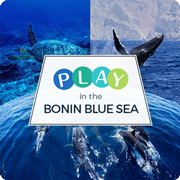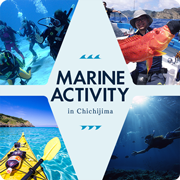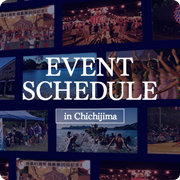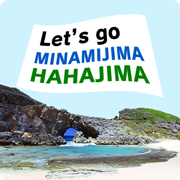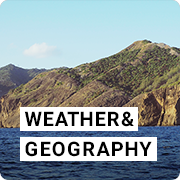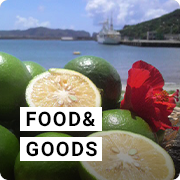WEATHER & GEOGRAPY

Weather in Ogasawara
Ogasawara belongs to subtropical. It's warm throughout the year with narrow annual temperature range. It also belongs to oceanic climate and it's cooler than mainland in summer and warmer in winter.
Rainfall
Precipitation rate is high in May and November. It is said that there's no rainy season in Ogasawara, as rainy season front usually appears north of the Islands.
Seems like it rains a lot for about a month, after Golden Week. Once rainy season front reaches mainland, Ogasawara is covered by a Pacific high and weather and ocean stays calm.
Four Seasons in Ogasawara
Spring
Cold windy days and warm days come alternately, just like mainland.
Summer to Autumn
Once the summer really comes, temporary squall falls on sunny days.
Winter to Spring
From winter to spring, strong wind may blow due to the influence of front over the mainland.
Sunlight is very strong throughout the year. Make sure to prepare for UV protection, even in winter or cloudy days.
Typhoon
When the water temperature rises, typhoon occurs on the ocean south of Ogasawara. Typhoon rarely hits Ogasawara but pass close by the Islands.
Schedule for Ogasawara Maru (liner ship) may change due to typhoon but voyage rarely cancelled. For the latest information on schedule, please contact Ogasawara Kaiun, the vessel operator.
Geography, topography and geology of Ogasawara
The Ogasawara Islands located approximately 1,000 km apart from mainland, are oceanic island formed by volcanic activity.
The islands include the Mukojima Isnlands, Chichijima Islands, Hahajima Islands, Iwo Islands, Okinotorishima, Minami-torishima, and Nishinoshima from north to south.
The only inhabited islands are Chichijima and Hahajima.
Longitude of Ogasawara is almost same as Okinawa and distance between Chichijima and Hahajima is approximately 50km. Land of Chichijima is 23.45 square kilometer and hahajima is 19.88 square kilometer.
The Ogasawara Islands gives you hints to understand how the oceanic arc was created and evolved, history for formation of the continent.
The Chichijima Islands
The Chichijima Islands were born by submarine volcanic activity.
48 million years ago, the Philippine Sea Plate started to subduct into under the Pacific Plate.
The water spread from the plate lowered melting point of the high temperature mantle under the plate and melted widely. This peculiar magma turned into Boninite.
The submarine volcanic activities caused by this magma lasted till 45 million years ago and latere became the Chichijima Islands and the Mukojima Islands.
The Hahajima Island
The Hahajima Islands was created after the Chichijima Islands caused by volucanic activity.
As the cold plate subducted, temperature of mantle lowered and by the time of 44 million years ago, magma started to melt in even deeper area.
Magma changed its nature and basaltic magma occurred, instead of Boninite. This volcanic activity made the Hahajima Islands.
Subduction of the plate still continues today and volcanic activity at Iwo Jima of the Volcanic Islands is still in progress.
Boninite
Boninite created when the Chichijima Islands were born is one of the special andesite which occured at the period of Island arc creation.
Boninite contains pyroxenes called Monoclinic Enstatite.
Althoug this mirenarl can be found in meteorite, it is very rare minreral contained only in Boninite on the earth.
English name for the Ogasawara Islands is "the Bonin Islands".
As you can tell from the name "Boninite", this boninite is the most extensively exposed in Ogasawara and it is well-preserved.
Topography
In Minamijima in the southwest marine area of Chichijima and Sekimon area of Hahajima, you can see "the karst landform" created from erosion and weathering.
Particularly on Minamijima, you can see the rock with sharp point called "lapies" and mortar-shaped depression called "doline".
In addition, Minamijima area is an unusual place in Japan where you can see submerged karst terrain which karst terrain sinks into the ocean.
Furthermore, in ogasawara where terrain continues to rise, you can see the sea cliff like Chichijima's "Chihiroiwa" over 200 meters high off the ground, the pillow lava created by eruption of submarine volcano.
And in Hahajima, you can see the large fossil of foraminifera "nummulite".
Our Picks For You
World Natural Heritage registration
The Ogasawara Islands were registered as a World Natural Heritage in June 2011.
For more information on the nature of Ogasawara Ogasawara Nature Information Center website.


